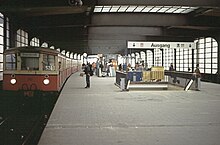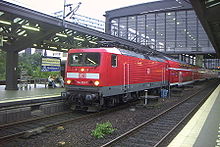Berlin Zoological Garden train station
| Berlin Zoological Garden | |
|---|---|
|
Berlin Zoologischer Garten station at night
|
|
| Data | |
| Location in the network | Intermediate station |
| Design | Through station |
| Platform tracks | 4 (long-distance train, above) 2 (S-Bahn, above) 4 (subway, below) |
| abbreviation | BZOO BZOS (S-Bahn) |
| IBNR | 8010406 |
| Price range | 2 |
| opening | February 7, 1882 |
| Website URL | sbahn.berlin |
| Profile on Bahnhof.de | Berlin_Zoological_Garden |
| location | |
| City / municipality | Berlin |
| Place / district | Charlottenburg |
| country | Berlin |
| Country | Germany |
| Coordinates | 52 ° 30 '26 " N , 13 ° 19' 57" E |
| Railway lines | |
|
|
| Railway stations in Berlin | |
The Berlin Zoologischer Garten railway station (short Zoo Station ) is a railway station of the Deutsche Bahn in Berlin district of Charlottenburg on Hardenberg place close to the Berlin Zoo .
The through station on the Berlin Stadtbahn is one of the more than 80 stations in the second-highest price class of DB Station & Service and is a transfer point between S-Bahn , Regional Express and Regionalbahn trains.
The underground station of the same name belonging to the Berliner Verkehrsbetriebe (BVG) belongs to the station complex . At the bus station on Hardenbergplatz there is a connection to the bus services (including metro and night buses ) of the BVG .
During the division of Berlin , the train station was the most important junction for long- distance passenger traffic in the western part of the city .
history
Opening and construction of the wall
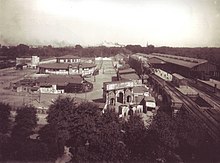
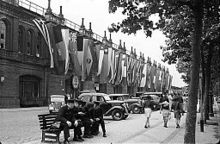

On February 7, 1882, the "Berlin City Railway", and with it the Zoologischer Garten station with a 71 meter long hall , was opened for "local traffic". From 1884, suburban trains and long-distance trains on the east-west routes stopped there in the station, which was provided with a second platform under a 109 meter long hall. Initially, the station was located in the large city of Charlottenburg, which was independent until 1920 .
In 1902 the underground station of today's underground line U2 , at that time the first underground line in Berlin, went into operation.
For the Olympic Games planned for 1936 , the station was fundamentally rebuilt and the tracks of the long-distance railway expanded. While maintaining the entire railway operations, the complete demolition and rebuilding of the station began in 1934. First of all, the S-Bahn was given its own separate hall above a central platform , it is 169 meters long and 21 meters wide. With a height of almost six meters, it could be kept low because the electric S-Bahn trains now in use did not develop any smoke. Opposite the previous S-Bahn hall, it is offset towards Jebensstraße and crosses Hardenbergstraße in its western section . A sweeping system was built east of the platform . The first trains stopped there in October 1935, but due to structural problems at the bridge over Hardenbergstrasse, the structure could not be finally opened to traffic until December 1938.
The construction of the new long-distance railway hall dragged on until 1940. The two central platforms were laid out 12.00 and 12.80 meters wide. The hall was only glazed a few years after the Second World War . The bridge structures were proposed in 2007 for the award as a ' Historic Landmark of Civil Engineering in Germany '.
After the closure of the other long-distance and terminal stations in the western sector of Berlin on May 18, 1952, the Zoologischer Garten station was the only remaining long-distance station in West Berlin . Although it only had two platforms for long-distance traffic, it was the most important railway junction in the western part of the city. It was the starting point for the interzonal and later transit trains into the federal territory.
Before the Wall was built and from 1962 onwards, long-distance trains ran from the Zoo station - either directly or by coach - to Copenhagen , Stockholm and via Prague to Vienna . The international east-west connections to Warsaw were not interrupted in 1961. Until 1976, only the Friedrichstrasse border station in East Berlin could be used as an additional long-distance station for West Berlin . It was not until 1976 that long-distance trains also stopped at the Wannsee and Spandau stations .
Social focal point
In the 1970s and 1980s, the back of the train station on Jebensstraße was a meeting place for the drug and prostitute scene . The book Wir Kinder vom Bahnhof Zoo , which was written down by Kai Hermann and Horst Rieck based on tape protocols by Christiane F. , deals with everyday life in the drug scene from the point of view of those affected. This publication gave the station a dirty image across Germany. The Berlin Senate Department put an end to these processes at the train station in the late 1980s through rigorous police operations. Nevertheless, the Zoologischer Garten station continues to be a meeting point for many homeless people , sex workers and drug addicts, especially on the bridges of the railway tracks. A facility of the station mission serves primarily as a contact point.
Electrification of the long-distance tracks

From July 3, 1993, when the electrical overhead line went into operation , the Zoo station was served by ICE trains as planned . This means that a previously set up shuttle service from the temporary ICE station in Michendorf to the operational terminus in Lichtenberg was no longer required .
On February 15, 2004, the station was declared a "smoke-free station".
On July 7, 2005, Deutsche Bahn announced that it would run ICE trains on the Cologne – Berlin and Stuttgart / Basel – Berlin lines even after the north-south tunnel went into operation, but would no longer stop at the Zoo station. Around 20,000 long-distance travelers per day were last counted at the Zoo station.
With the implementation of the mushroom concept for the timetable change on May 28, 2006, the train routes in the Berlin railway junction were reorganized and the new long-distance stations Hauptbahnhof , Südkreuz and Gesundbrunnen opened. The Berlin-Spandau station has been upgraded with additional train stops. Since then, ICE and IC trains have stopped at Zoologischer Garten station . On the night of the timetable change, representatives of a citizens' initiative laid a memorial wreath for the last scheduled ICE to stop. By then they had collected around 130,000 signatures for the Zoo station to be kept as a long-distance train station. Most recently, 146 long-distance trains stopped daily.
While numerous travelers benefit from an increase in daily train stops from around 1200 to around 1700 as well as from significantly reduced travel times in the north-south direction, the implementation of the mushroom concept has led to an increase in travel time for rail customers, especially those coming from the western city center travel to West Germany. These customers often have to take S-Bahn or regional trains to Spandau station in order to get a connection to long-distance transport. The main train station is 3.8 kilometers by rail and the Spandau train station 11.6 kilometers from the Zoo train station. Longer travel times also result in some cases for passengers from the Berlin area with destinations in the western inner city .
The number of daily visitors to the station fell from around 150,000 to around 100,000. As a result, retailers in the station complained about a massive drop in sales. According to information from Deutsche Bahn from December 2006, the station also lost its importance as the most important regional hub in Berlin and now ranks second behind Friedrichstrasse station. While 45 percent of all tickets in Berlin were previously sold at the Zoologischer Garten train station, in December 2006 it was 25 percent. Shortly after the end of the long-distance traffic stop, the Terrassen am Zoo restaurant , which had up to 600 guests a day, closed. At the beginning of 2008, around 130,000 travelers used the station every day. All commercial space is now rented again.
In terms of the number of daily passengers in regional traffic, the Zoo station was in second place behind Friedrichstrasse station at the end of 2006 , followed by Alexanderplatz station in third place.
In addition to regional and S-Bahn trains, night trains from Deutsche Bahn and long-distance trains from other railway companies also stop. Trains to Eastern Europe ( Saint Petersburg , Moscow , Kiev and others), which were previously used in Lichtenberg station, now also start at Zoo station .
Critics criticize DB's decision. The Zoo station has always been a long-distance station since 1884 and in all DB publications on the mushroom concept that were published up to March 2005 the station was identified as a long-distance stop.
The coalition agreement of the Berlin Senate (status: 2013) included a long-distance traffic stop at the Zoo station as a destination.
The Interregio-Express (IRE) Berlin - Stendal - Salzwedel - Uelzen - Lüneburg - Hamburg has stopped here since April 14, 2014 - now twice a day in each direction - which takes a little more than three hours for this connection. However, the IRE is operated by DB Regio and can be used with tickets for local trains.
When the night train CNL 1246/1247 was discontinued , the station lost its otherwise last long-distance train stop with Deutsche Bahn trains when the timetable changed in December 2015. Since December 2016 a long-distance train (IC 446 on the way to Cologne) has stopped at Zoo station. The FLX 10 line from Flixtrain (Stuttgart - Berlin), the ICE train pair 948/949 (Cologne - Berlin) and the Nightjet 470/471 from ÖBB (Zurich - Berlin) currently stop at Zoo station .
Ongoing renovation
Deutsche Bahn is currently renovating the station, initially around 15 million euros (as of 2016). There was a repeated renewal of the track system in 2006, previously also in 1984 and 1991–1993. The company emphasizes that this renewed construction work is only possible thanks to the reduced train traffic since the ICE and IC stops were discontinued. The station building was originally to be modernized gradually by 2017. Among other things, the restaurant floor with the zoo terraces was renovated by the end of 2016 , but now no longer includes a classic restaurant, but a branch of McDonald’s .
In the meantime, Deutsche Bahn assumes that the costs will rise to 100 million euros due to the damage to the structure, and completion is now forecast for 2027.
Zoologischer Garten underground station

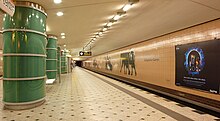
The underground station of today's U2 line, opened on March 11, 1902, was one of the first underground underground stations in the then still independent city of Charlottenburg . It has two side platforms running approximately in an east-west direction , which, as an underpaved tram, are only a few meters below the road surface. This station can only be used by trains in the small-profile network .
The platform of line U9 , which is located under the platform of line U2, crosses under the entire station forecourt almost in a north-south direction. This station for the large profile has a central platform with the main exit on the south side and another exit on the north side. The tiled walls of the station are decorated with depictions of animals in order to create a connection to the nearby zoo. Both underground stations are L-shaped to each other.
The Kurfürstendamm underground station on the U1 and U9 lines is around 350 m south of the Zoologischer Garten station.
Zoologischer Garten bus station
The largest bus station in Berlin is located on Hardenbergplatz. In contrast to the Central Bus Station (ZOB) on the exhibition grounds , which is used for long-distance bus traffic, it is mainly served by local public transport buses . In addition to a stop for incoming buses, the bus station consists of two bus platforms with a total of six stops. This is where the BVG bus lines M45, M46, M49, X9, X10, X34, 100, 109, 110, 200, 204, 245 and 249 end. The bus station is also of particular importance in night traffic. In addition to the stops at Alexanderplatz, it is one of two main connections where the night bus lines meet in two half-hourly waves.
Connection
Others
One of the offices for visiting and travel affairs (BfBR) was located in Jebensstrasse opposite the train station. Here, citizens of West Berlin were given a “ certificate of authorization to receive a GDR visa ” to enter East Berlin or other GDR districts . The museum of the Helmut Newton Foundation is currently located on Jebensstrasse. This building was of particular importance to Helmut Newton as it was one of the last he had seen from the train when he escaped from Berlin in 1938.
Friends of rock music the station is by the song Auf'm Bahnhof Zoo the Nina Hagen Band from the same album known.
In his work Russen , published in 1984, Udo Lindenberg mentions the “Politbüro am Bahnhof Zoo”.
In 1991, the station inspired the Irish rock band U2 to write Zoo Station while they were recording the album Achtung Baby in Berlin.
There is also a song by the Swedish punk rock band Randy entitled Bahnhof Zoo , in which the lack of perspective and the social problems of young people at the time was described.
literature
- Berlin S-Bahn Museum (ed.): Bahnhof Zoo - outpost of the GDR in West Berlin . GVE-Verlag, Berlin 2011, ISBN 978-3-89218-101-9 .
- Berlin Rail Transport Association (Hrsg.): Long-distance train station Zoologischer Garten . GVE-Verlag, Berlin 1985.
Web links
- Berlin Zoological Garden on the Deutsche Bahn website bahnhof.de with a map (PDF; 0.64 MiB)
- Tracks in service facilities (BZOS) , DB Netz AG (PDF; Schematic track plan on dbnetze.com)
- Location, track systems, signals and permissible speeds on the OpenRailwayMap
- Location plan of all shops on shoppingbahnhof.de
- S and regional train station Berlin Zoo
- Bahnhof Zoo Berlin - Interactive 360 ° panorama
- S-Bahn station Zoologischer Garten at stadtschnellbahn-berlin.de
- Entry in the Berlin State Monument List
- BVG map of the station (PDF; 191 KiB)
Individual evidence
- ↑ Station price list 2020. In: Deutsche Bahn. Deutsche Bahn, January 1, 2020, accessed on July 11, 2020 .
- ↑ Query of the course book route 200 at Deutsche Bahn.
- ↑ Query of the course book route 200.5 at Deutsche Bahn.
- ↑ Query of the course book route 200.7 at Deutsche Bahn.
- ↑ Query of the course book route 200.75 at Deutsche Bahn.
- ↑ Query of the course book route 201 at Deutsche Bahn.
- ↑ Query of the course book route 202 at Deutsche Bahn.
- ↑ Query of the course book route 207 at Deutsche Bahn.
- ↑ Query of the course book route 209.14 at Deutsche Bahn.
- ↑ Query of the course book route 260 at Deutsche Bahn.
- ↑ Query of the course book route 260.5 at Deutsche Bahn.
- ^ Stadtbahn-Historie in: Eisenbahnstadt Berlin (Eisenbahn Journal Special 2/2015), p. 50
- ^ A b Alfred Gottwaldt: Berliner Fernbahnhöfe . 5th edition. Alba, Düsseldorf 1991, ISBN 3-87094-224-X , p. 84 .
- ↑ Jürgen Meyer-Kronthaler, Wolfgang Kramer: Berlin's S-Bahnhöfe. Three quarters of a century . Be.bra, Berlin 1998, ISBN 3-930863-25-1 , p. 365 ff .
- ↑ Berlin Central Station inaugurated . In: Eisenbahn-Revue International . Issue 7, 2006, ISSN 1421-2811 , pp. 323 .
- ↑ ICE drives to the zoo in Berlin . In: Railway technical review . tape 42 , no. 7/8 , 1993, pp. 429 .
- ↑ Smoke-free train stations in Berlin . In: Eisenbahn-Revue International . Issue 4, 2004, ISSN 1421-2811 , pp. 148 .
- ↑ Berlin: Ringbahnhalle “Südkreuz”, two-track in operation . In: Eisenbahn-Revue International . Issue 8–9, 2005, ISSN 1421-2811 , pp. 365 f .
- ↑ Berlin S-Bahn with a new timetable . In: Eisenbahn-Revue International . Issue 7, 2006, ISSN 1421-2811 , pp. 368 .
- ^ Deutsche Bahn (Ed.): Bahnstadt Berlin: Expansion of the infrastructure from 1990 to 2015 . Berlin, 2006, p. 83.
- ↑ One year of new traffic concept - expectations have been met . In: Punkt 3 (PDF; 2.7 MiB), edition 10/2007, p. 12f.
- ↑ Train path price software 2011 (as of October 2010) ( Memento from May 13, 2012 in the Internet Archive ) from DB Netz AG .
- ^ Andrea doll: Tristesse at the Zoo station. In: Berliner Morgenpost . June 23, 2006, archived from the original on June 25, 2006 ; accessed on January 19, 2018 .
- ↑ a b Berliner Verkehr: Hauptbahnhof is proving its worth. In: Der Tagesspiegel . December 24, 2006, accessed January 19, 2018 .
- ↑ a b Life after long-distance travel. In: Berliner Morgenpost , April 1, 2008.
- ↑ Milestone in the construction of Berlin Central Station . In: Eisenbahn-Revue International , issue 10/2005, p. 495.
- ↑ Klaus Kurpjuweit: a tight spot at the zoo . In: Der Tagesspiegel . No. 21800 , September 5, 2013, p. 14 ( similar version ).
- ↑ DB long-distance traffic in 2016 . In: Eisenbahn-Revue International . No. 1 , 2016, ISSN 1421-2811 , p. 46-47 .
- ↑ a b c Klaus Kurpjuweit: Another Intercity stops at the Zoo station. In: tagesspiegel.de. October 30, 2016. Retrieved October 30, 2016 .
- ↑ a b Isabell Jürgens: Beauty treatment for the Zoologischer Garten station. In: The world . August 31, 2006, accessed January 19, 2018 .
- ↑ J. Fahrun, T. Fülling, I. Jürgens: How the railway wants to modernize the Zoo station from 2015. In: Berliner Morgenpost . January 23, 2014, accessed January 19, 2018 .
- ↑ Kerstin Schwenn: Our train station should be more beautiful . In: Frankfurter Allgemeine Zeitung . No. 135 , June 15, 2015, ISSN 0174-4909 , p. 19 ( faz.net ).
- ↑ News in brief - Railway . In: Berliner Verkehrsblätter . No. 3 , 2020, p. 56 .
- ^ Museum of Photography / Helmut Newton Foundation
- ^ Text Russians Udo Lindenberg


